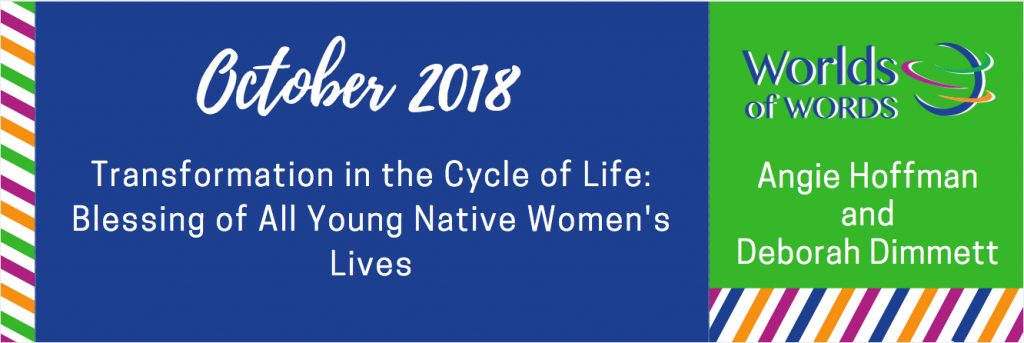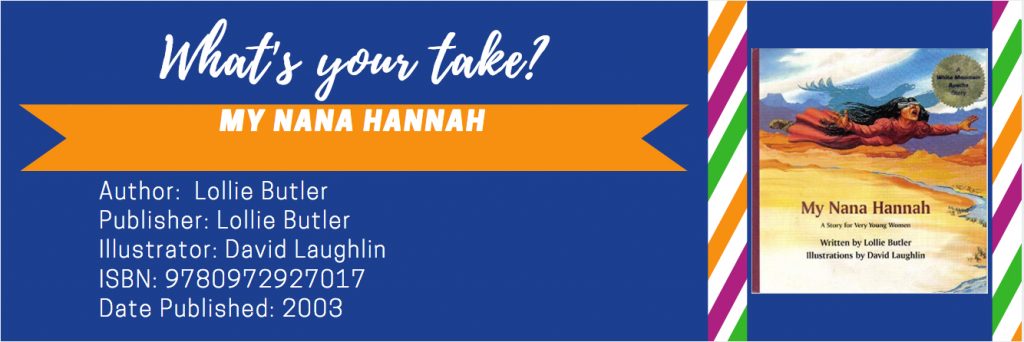 In the first installment of October’s MTYT, Deborah Dimmett and Angie Hoffman are excited for the opportunity to share a sampling of children’s books written by Native American authors who bring to the young reader a deeper understanding about Native American traditions and perspectives. In particular, the theme this month provides a view into the cycle of life of young native women. We will discuss four books this month: My Nana Hannah, For a Girl Becoming, The Gift of Changing Woman and Kinaalda: A Navajo Girl Grows Up.
In the first installment of October’s MTYT, Deborah Dimmett and Angie Hoffman are excited for the opportunity to share a sampling of children’s books written by Native American authors who bring to the young reader a deeper understanding about Native American traditions and perspectives. In particular, the theme this month provides a view into the cycle of life of young native women. We will discuss four books this month: My Nana Hannah, For a Girl Becoming, The Gift of Changing Woman and Kinaalda: A Navajo Girl Grows Up.
DEBORAH: My Nana Hannah is a rich and loving narrative from the point of view of a young girl who shares the girlhood stories of her nana Hannah. Written in the first person, the young girl describes some of the many Apache traditions her nana experienced growing up as a young woman. She highlights the traditions from birth through the final stages of life in which her nana, a respected elder in the community, reaches the age of ninety. Nana Hannah will leave her stories to be cherished and retold by her forty-seven granddaughters who will then share with their daughters.
Throughout the book, the author uses verse as a device to mark time and the rights of passage Nana experiences as she grows up.
When my nana Hannah was thirteen,
She flew a goshawk through the air,
She danced in a circle of women
And grew her black hair down to there…
Each story concludes with a similar verse that maintains the final line, “And grew her black hair down to there.” The length of hair is an important trope for Nana’s increasing strength and wisdom with the passage of time.
Each phase of Nana’s life is colorfully described with remarkable moments that are surreal, if not magical. The young girl describes Nana’s coming of age when she turns 13 years old.
It was a special time for the young girl Hannah. She was allowed to dance at the women’s fire. She danced for four days while a hawk circled overhead, and the voice of the drum echoed in the hills. Round and round Hannah danced until she grew dizzy and felt wings lift her high into the air. She saw distant red cliffs and smoke from faraway fires.
Hannah’s transcendence into womanhood is truly special as the author describes this moment as an occasion that will never occur again in her life. Hannah not only experienced a physical transcendence but also a spiritual one where she gains a new perspective as she flies over the village from where she was born. As a reader I wanted to hang onto that moment in the book. The illustrations help facilitates readers to hold onto the image and explore the significance of the story. For Hannah’s coming of age, the two-page spread depicts her flying through the air and over her village as she gains insights that she never had as a young girl. In flight she learns the significance of the river, the land and the surrounding mountains to the lives of the people in her village. She learns this through the animal spirit of an eagle that is accompanying her in flight.
Each story shared by Nana is as rich as the story before it. Each story invites us to explore other ways of knowing and understanding our life in the world. As I read this picture book, I wondered how young girls of Apache or other American Indian heritage might connect to the stories described in the book. Moreover, how do the stories facilitate the passing down of knowledge and traditions from their mothers and grandmothers? Furthermore, I wondered how young girls who do not have an American Indian heritage would understand the stories told. Regardless of our cultural heritage and upbringing, I concluded that every mother and grandmother could share with their daughters and granddaughters their own experiences growing up and these experiences will be full of wonderment and rich traditions.
Angie: My Nana Hannah is a book introduced to me by my sister because the author of this story came to her daughter’s classroom to read the story. My niece was amazed when she realized that the author was not Apache. My sister gave me this book to read because she knows my specialty in authentic indigenous children’s literature.
The narrative story is about an Apache girl. It tells the tale of her growing up from an infant to a child, coming into womanhood and getting married. The rest of the story talks about her becoming an Elder with generations of grandchildren, great-grandchildren and great-great grandchildren.
There are several examples of inaccuracies in both the illustrations and the writing. On pages two and three, the main character Hannah is in a cradleboard, and the cradleboard isn’t portrayed accurately. The Apache create them using pine trees, cedar trees or oak. The part where they create it using a lightning struck tree is not factual because this is not allowed in the construction of a cradleboard. The wickiup is also inaccurate. For White Mountain Apache, wickiup is made up of bear-grass, yucca and poles for the frame.
On pages six and seven, the author depicts Hannah’s friend putting eagle feathers in her hair. In an accurate depiction of Apache culture, the godmother would place an eagle feather in her hair. The parts about Hannah dancing and being expected to see a vision are accurate, however the reference to the “first star wrinkled like a snow owl” is inappropriate. In Apache culture, an owl is not a good sign and brings bad luck to the family.
On pages ten and eleven, the illustration of the buckskin is inaccurate and the men wearing a bear mask is wrong. The bear is one of our four clans and Apache would never kill one.
On pages twelve and thirteen, Hanna fed them corn piki and pinon. Apache women do not make corn piki.
As a White Mountain Apache woman, I habitually read indigenous children’s literature and take note of the authenticity, or lack thereof, in regard to the factual depiction of indigenous people. I thought My Nana Hannah was a cute story, but it does not accurately portray Apache traditions. As an author and illustrator, I believe there is a substantial responsibility to conduct thorough research about which the people one is writing. Meticulous research leads to the creation of a story that is culturally authentic and is both positive and validating for indigenous people.
DEBORAH: In reading Angie’s take, I am reminded how important it is to not base first impressions on the perspectives of one author, especially if the author is not sufficiently knowledgeable about the local traditions and folkways of the culture s/he is writing about or illustrating. As an outsider, I saw the story as far more representative of the White Mountain Apache people than Angie, who is Apache and lives the culture. Although the story is very nice, it is not very authentic. Does this mean that the story has no value? That would depend on how the story is framed. As a parent or teacher, I would value the author’s and illustrator’s storytelling while making sure to note that their representations are inaccurate in a variety of instances.
Title: My Nana Hannah
Author: Lollie Butler
Illustrator: David Laughlin
Publisher: Lollie Butler
ISBN: 9780972927017
Date Published: 2003
This is the first installment of October’s issue of My Take/Your Take. Check back next week to see what books we’ve selected and to follow the conversation!
- Themes: Angie Hoffman, Deborah Dimmett, My Nana Hannah
- Descriptors: Books & Resources, My Take/Your Take

